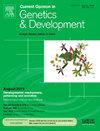种系和早期胚胎的着丝粒调控
IF 3.6
2区 生物学
Q2 CELL BIOLOGY
引用次数: 0
摘要
着丝粒对基因组遗传至关重要,是着丝粒组装和最终姐妹染色单体凝聚的场所,以确保细胞分裂过程中染色体的准确分离。在两性生殖系和早期胚胎发育过程中,这些作用必须通过染色体的根本物理变化和其他生物学挑战而持续存在。在大多数生物体中,着丝粒是由一种组蛋白H3变体CENP-A的存在在表观遗传学上定义的。因此,为了维持着丝粒,CENP-A核小体必须通过种系跨代遗传。然而,配子体发生的独特方面,包括雌性生殖系的不对称减数分裂和细胞周期阻滞延长以及雄性生殖系中广泛的染色质重组,为着丝粒遗传过程引入了额外的复杂性。在这里,我们回顾了这些过程在配子体发生和早期胚胎发育过程中的着丝粒调节的意义,并借鉴了小鼠和果蝇模型的研究结果。本文章由计算机程序翻译,如有差异,请以英文原文为准。
Centromere regulation in the germline and early embryo
Centromeres are essential for genome inheritance, serving as sites for kinetochore assembly and for final sister chromatid cohesion to ensure accurate chromosome segregation during cell division. These roles must persist through radical physical changes to chromosomes and other biological challenges presented by specialized processes in the germlines of both sexes and during early embryonic development. Centromeres in most organisms are epigenetically defined by the presence of a histone H3 variant, CENP-A. Therefore, to maintain centromeres, CENP-A nucleosomes must be inherited across generations through the germline. However, unique aspects of gametogenesis, including asymmetric meiosis and prolonged cell cycle arrest in the female germline and extensive chromatin reorganization in the male germline, introduce additional layers of complexity to the process of centromere inheritance. Here, we review the implications of these processes for centromere regulation during gametogenesis and early embryonic development, drawing on findings from mouse and fruit fly models.
求助全文
通过发布文献求助,成功后即可免费获取论文全文。
去求助
来源期刊
CiteScore
7.90
自引率
0.00%
发文量
102
审稿时长
1 months
期刊介绍:
Current Opinion in Genetics and Development aims to stimulate scientifically grounded, interdisciplinary, multi-scale debate and exchange of ideas. It contains polished, concise and timely reviews and opinions, with particular emphasis on those articles published in the past two years. In addition to describing recent trends, the authors are encouraged to give their subjective opinion of the topics discussed.
In Current Opinion in Genetics and Development we help the reader by providing in a systematic manner:
1. The views of experts on current advances in their field in a clear and readable form.
2. Evaluations of the most interesting papers, annotated by experts, from the great wealth of original publications.[...]
The subject of Genetics and Development is divided into six themed sections, each of which is reviewed once a year:
• Cancer Genomics
• Genome Architecture and Expression
• Molecular and genetic basis of disease
• Developmental mechanisms, patterning and evolution
• Cell reprogramming, regeneration and repair
• Genetics of Human Origin / Evolutionary genetics (alternate years)

 求助内容:
求助内容: 应助结果提醒方式:
应助结果提醒方式:


